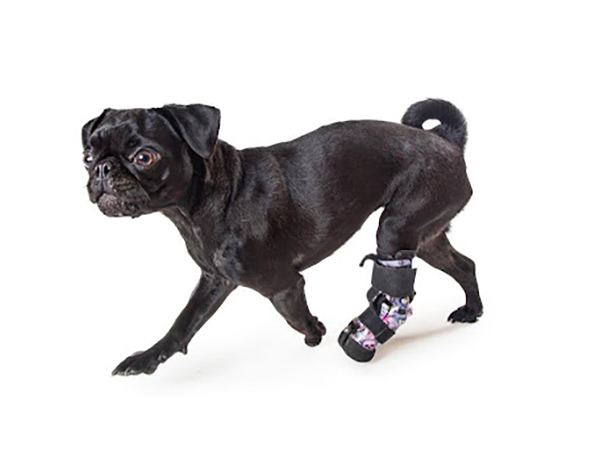 Prosthetics have the power to change lives. The technology has come a long way in a few short years, with prosthetics allowing for huge improvements in mobility and comfort for humans and animals alike. Prosthetics are an increasingly realistic solution in modern veterinary care.
Prosthetics have the power to change lives. The technology has come a long way in a few short years, with prosthetics allowing for huge improvements in mobility and comfort for humans and animals alike. Prosthetics are an increasingly realistic solution in modern veterinary care.
This trend is driven, in part, by recent technological improvements, including manufacturing changes that have made prosthetics much more affordable. In fact, rather than being deterred by the possibility of paying for prosthetics, animal lovers are actively seeking out pets who need them.
Explaining the thinking behind this trend, Tripawds (a pet amputation support website) co-founder Rene Agredano tells Wired that, “People are drawn to specially-abled pets” in part because human companions simply want to help animals achieve an “equal chance at having a happy life.”
This desire to help (and sense of satisfaction upon achieving that end) is evident based on the sheer popularity of feel-good success story videos, highlighting surprisingly mobile pets equipped with prosthetic limbs.
Animal prosthetics technology is already downright impressive, but further improvements are on the horizon. Below, we will explain how far prosthetics have come and what’s in store for the future.
What Is the Current Process of Creation for Animal Prosthetics?
The standard process for building prosthetics begins with a careful assessment of the animal and the viability of prosthetics. As Dr. Sherman Canapp, a board-certified veterinary surgeon, tells VIN News, suitability depends on how much, if any, of the limb is intact. “Those hinges are so important and give you much more ability to make a more functional device for the animal.”
Once animals are approved, the creation process begins with developing a plaster cast, although digital scanning can also be used to determine the necessary proportions. This is followed by the creation of a mold, which can be modified as needed to better fit the animal in question.
See-through sockets known as test sockets may be needed to determine whether any pressure areas exist and how these could contribute to the animal’s discomfort over time. Once the prosthetist feels confident that a proper fit has been achieved, the final prosthetic can be created and fitted.
This process can be expensive and time-consuming, but advocates believe that, when both animals and their human companions are amenable, the advantages make the challenges worth navigating.
What Challenges Are Faced With Prosthetics Today?
Animal prosthetics are promising, but far from perfect. As we’ve mentioned, not all animals will be great candidates and, even when they are, cost could be a significant barrier. Other key concerns worth addressing include:
Getting Used to New Prosthetics
Even the best prosthetics take some getting used to and, for many animals, the adjustment period will prove challenging. This depends, to some degree, on temperament; some animals seem to take naturally to new prosthetics, while others struggle to adjust.
Such issues can sometimes be addressed through rehabilitative efforts that we will describe below. Beyond this, however, animals may simply need to undergo an adjustment period or may even require multiple sets of prosthetics as they adapt to new alignments.
Dealing With Sweat
Moisture absorption represents an ongoing challenge for both human and animal prosthetics. Despite common misconceptions, animals have sweat glands and can produce small amounts of sweat. While this is typically not sufficient for effective cooling, it can have an impact on the fit and function of prosthetics. Limbs are better capable of regulating body temperature than prosthetics, so in hot weather or while exercising, unwanted sweat and moisture are likely.
Strengthening Limbs
Many animals go months or even years with a stump before they receive prosthetics. Over time, the muscles of the remaining limb weaken. This can make the transition to using prosthetics a lot more difficult, as animals will first need to regain strength in the affected limbs.
This is where rehabilitation can help. Common solutions include massage and core strengthening exercises. Many animals are tasked with walking on underwater treadmills. Some pets may also benefit from losing weight, as this can limit strain on the joints.
Handling Changing Limb Shape
The age at which animals receive prosthetics can make a huge difference and may determine how well they adapt to these devices and how long they are able to use them. Younger animals, for example, may adapt quickly to new prosthetics that are provided shortly after an amputation, but there is a distinct downside: these young animals won’t stay young or small forever.
As limbs change in size and shape, previously well-fitting prosthetics may no longer be ideal. Modest adjustments such as refitting or lengthening may be possible, but, in some cases, prosthetics will need to be remade altogether.
Handling Phantom Limb Pain
Phantom limb pain (PLP) is a poorly understood phenomenon that occurs when amputations prompt a disorienting sensation that something is missing. Humans who suffer PLP have described it as a throbbing or tingling sensation, perceived to exist in the area of the body that was amputated.
PLP is not to be confused with residual limb pain (RLP), which is sometimes referred to as “stump pain” and typically resolves as the wound causing the pain begins to heal. PLP, however, may persist years after the limb was amputated. In fact, insights published by dvm360 suggest that PLP become a chronic source of neuropathic pain, potentially even worsening with time.
While PLP has not been extensively researched at the veterinary level, considerable evidence suggests that it not only exists, but that it can be highly distressing for the animals that experience it. In multiple studies, pain-related markers have been observed in animals who have undergone amputations.
Easily observable signs of PLP in animals include licking or twitching of the stump. This can be difficult to detect, however, and in a study published in the Journal of Veterinary Behavior, researchers hope for an increased ability to “recognize behavioral signs that may indicate the presence of unpleasant sensations related to neuropathic pain.”
At present, there is no reliable solution to PLP, although some researchers believe that conducting amputations earlier may reduce the risk, as animals experiencing long-term chronic pain in the eventually amputated area are more likely to eventually suffer PLP.
The Different Types of Animal Prosthetics
Animal prosthetics are largely classified based on where they are required. This also determines suitability for prostheses, with partial-limb solutions typically proving more effective.
Another consideration: some animals may only require one prosthetic, while others may need multiple. Common areas that call for prosthetics include:
- Transradial. Required below the elbow, transradial prosthetics may be required after pets suffer severe trauma to their paws. Animals that are solid candidates for these prosthetics will have undergone amputations several inches below the elbow.
- Transfemoral. Designed to replace amputated limbs above the knee, transfemoral prosthetics serve as full-leg solutions. One of the main goals is to assist the other legs with weight distribution.
- Transtibial. Prosthetics required below the knee are typically referred to as transtibial. These may call for shock-absorbing pylons, which can be fitted near the paw to limit impact forces while walking.
- Transhumeral. As another full-limb solution, transhumeral prosthetics can sometimes prove helpful following amputations above the elbow. Like transfemoral prosthetics, transhumeral solutions may provide relief for weight-bearing limbs.
The Future of Prosthetics
The prosthetic revolution is just beginning. While today’s prosthetics seem impossibly advanced, exciting improvements are just around the corner. Below, we’ve highlighted solutions that are already well underway in the rapidly evolving prosthetics market and will be more readily available in the near future.
3D Printing
As modeling software improves, the possibility of creating prosthetics via 3D printing becomes more realistic. This cutting-edge solution serves as an affordable and highly customized alternative to the traditional prosthetics development process.
As the Medical Device Network explains, the technology underscoring 3D printed animal prosthetics has improved rapidly, “from use in rapid prototyping or scale modelling to the manufacturing of complex and precise industrial products,” making is an increasingly accessible option for humans and animals alike.
Microprocessor Joints
Offering an updated take on the traditional mechanical prosthetics, microprocessor-controlled solutions aim to replicate animals’ natural gait more closely, delivering far better stability, particularly in the aftermath of a transfemoral amputation. Microprocessors also alter the perception of stability, producing greater confidence so that those outfitted with prosthetics are less likely to shift excessive weight to their remaining limbs.
Different Prosthetics for Different Activities
Those unfamiliar with prosthetics often regard it as a one-and-done phenomenon; they assume that a person or animal is outfitted with a prosthetic meant to improve general mobility and facilitate a variety of activities. Increasingly, however, prosthetics are adapted for specific purposes. In humans, this often means optimizing prosthetics for athletic activities.
With animals, different types of prosthetics may deliver greater comfort in various scenarios. For example, some canine prosthetics are better suited to long walks than jumping up and down indoors, while others, as we’ve discussed, allow animals to adjust to using prosthetics in the first place.
Osseointegration
A strategy known as osseointegration promises to produce a direct connection between living bones and artificial implants. If successful, this strategy could lead to far greater mobility than would be possible with conventional prosthetics.
In recent years, researchers have investigated surgical advances involving bone-anchored prostheses, which can be customized to reduce the risk of implant failure. However, as a report published in Veterinary World makes clear, this practice remains controversial due to concerns surrounding “mechanical longevity of the implant system, durability of the bone anchorage, and rate of infection.”
Are Animal Prosthetics Necessary?
In many cases, animal prosthetics are critical, enabling an improved quality of life in both mobility and comfort for animals in the aftermath of amputation. That said, there are some limitations, even as the technology underscoring prosthetics for animals continues to improve.
Chief among these concerns is whether animals will actually accept prosthetics. Derrick Campana, MSPO tells the American Animal Hospital Association (AAHA), “Animals are incredibly adaptable, and resilient, but unable to rationalize the concept of an artificial appendage…If they’re in pain, a prosthetic is useful. If they aren’t in pain, it can be more of a burden.” With further improvements, however, we may see a greater share of animals readily accept prosthetics and experience the many benefits they have to offer.
Make a Difference in Veterinary Care
Learn how to impact animals’ lives with the Veterinary Assisting or Veterinary Technology program at Carrington College.
Sources:
- Ashworth, B. “Pet Prosthetics Get a Boost From 3D Printing.” Wired.
- Kelly, R. “Finding their feet: Pet prostheses inch toward mainstream.” VIN News.
- Pendergrass, J. “New Insights Into the Phantom Complex for Small Animals.” Dvm360.
- Menchetti, M., et al. “Approaching phantom complex after limb amputation in the canine species.” Journal of Veterinary Behavior.
- “A custom fit? 3D printing for prosthetic limbs.” Medical Device Network.
- Arauz, P., et al. “New technologies applied to canine limb prostheses: A review.” Veterinary World.
- McReynolds, T. “How prosthetics enable specially-abled pets.” NEWStat. American Animal Hospital Association.



